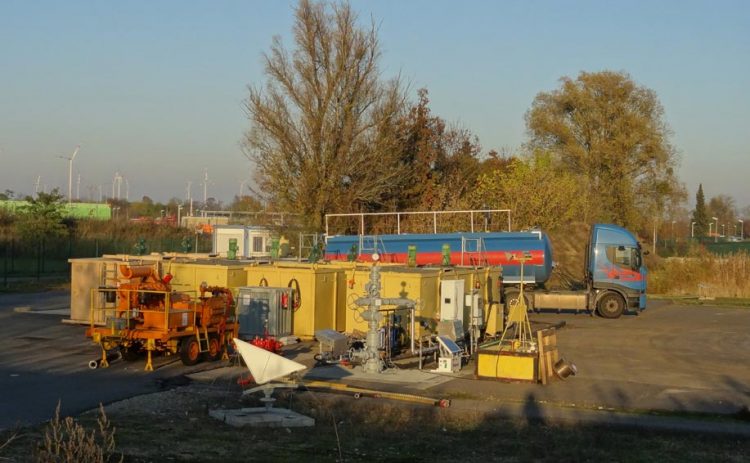Field experiment on brine injection in geological CO2 storage

A field experiment on brine injection at the pilot site Ketzin/Havel, operated by the German Research Centre for Geosciences (GFZ), ended successfully on 6th of January, 2016. It marks the last field experiment with respect to the geological storage of CO2 at Ketzin.
In the current field experiment, brine was continuously injected since 12th of October, 2015, into the CO2 reservoir, a porous sandstone layer located at a depth between 630 m and 650 m. During 88 days, almost 2,900 tonnes of brine were pumped into the CO2 storage.
The brine has a chemical composition comparable to the brine that naturally occurs in the reservoir rocks. The brine was delivered by tank trucks whereby several containers were used for the intermediate storage.
The GFZ pilot's location Ketzin accommodates Europe`s biggest research project related to the geologic storage of the greenhouse gas carbon dioxide. Since 2008, more than 67,000 tonnes of CO2 were stored in the underground in order to investigate this approach towards greenhouse gas reduction. The stored carbon dioxide replaced the salty natural pore water.
However, for a long-term storage it is expected that this pore water will flow back into the reservoir rock and mix with the injected CO2. The brine injection experiment simulated this natural backflow and the associated displacement of the CO2 in time-lapse mode.
Two main objectives were pursued in this regard: On the one hand it should be determined how much of the CO2 residing in the pore space can be displaced by the injected brine. On the other hand it should be examined which differences exist between the displacement of the formation fluids by CO2 during the CO2 injection and the displacement of the CO2 by brine during the brine injection.
Besides, the experiment is also another safety test: it is examined whether the brine injection is suitable as a possible remediation technique in case of a CO2 leakage by displacing the CO2 from the pores of the reservoir rock in the near wellbore area. “Our overall research results have shown that the geologic storage of carbon dioxide is a reliable and feasible way at adequate scientific and technical assistance“, according to Axel Liebscher, head of the section Geologic Storage at GFZ.
„The new findings on the brine and gas behaviour are central metrics in assessing the long-term behaviour and safety of CO2 storage. With the recent field experiment, we are now able for the first time to verify and validate the data on residual CO2 saturation, usually only derived from lab tests, under real geological conditions.“
The propagation of the injected brine and the associated displacement of the stored CO2 near the wellbore have been simulated before the field experiment started and it was monitored during the experiment in particular by aid of a geoelectric measuring system which recorded the electrical conductivity in the underground.
This monitoring network, which was already installed behind the casings in 2007 before the beginning of the real CO2 injection, permits conclusions on the spatial distribution of brine and CO2. Beside the geoelectric measurements, the field test was accompanied by continuous monitoring of pressure and temperature conditions in the injection well as well as in two neighbouring observation wells.
Already in October, 2014, another field experiment had been carried out successfully on the back production of CO2 from the storage reservoir. The operative life cycle of the CO2 storage in Ketzin is now finished within the running project COMPLETE.
In current year 2016, the remaining four wells will be backfilled successively and the site will be re-cultivated. The life cycle of the storage site ends finally with the return of the liability from GFZ to the mining authority of the federal state of Brandenburg after the integrity of the storage complex has been proved.
„Together with the knowledge from the active CO2 injection, both field experiments, the back production and the brine injection, enable us to understand the processes before, during and after a CO2 storage in detail and to prove the functionality and integrity of the CO2 storage at Ketzin“, Axel Liebscher concludes.
More information on the pilot site Ketzin can be found on the website: http://www.co2ketzin.de
Photo in printable solution may be found here:
https://media.gfz-potsdam.de/gfz/wv/05_Medien_Kommunikation/Bildarchiv/CO2MAN_CO…
Caption: Delivery and intermediate storage of brine for a continuously injection into a depth of 630 m, October 2015 (Photo: T. Kollersberger, GFZ)
Media Contact
All latest news from the category: Earth Sciences
Earth Sciences (also referred to as Geosciences), which deals with basic issues surrounding our planet, plays a vital role in the area of energy and raw materials supply.
Earth Sciences comprises subjects such as geology, geography, geological informatics, paleontology, mineralogy, petrography, crystallography, geophysics, geodesy, glaciology, cartography, photogrammetry, meteorology and seismology, early-warning systems, earthquake research and polar research.
Newest articles

NASA: Mystery of life’s handedness deepens
The mystery of why life uses molecules with specific orientations has deepened with a NASA-funded discovery that RNA — a key molecule thought to have potentially held the instructions for…

What are the effects of historic lithium mining on water quality?
Study reveals low levels of common contaminants but high levels of other elements in waters associated with an abandoned lithium mine. Lithium ore and mining waste from a historic lithium…

Quantum-inspired design boosts efficiency of heat-to-electricity conversion
Rice engineers take unconventional route to improving thermophotovoltaic systems. Researchers at Rice University have found a new way to improve a key element of thermophotovoltaic (TPV) systems, which convert heat…



